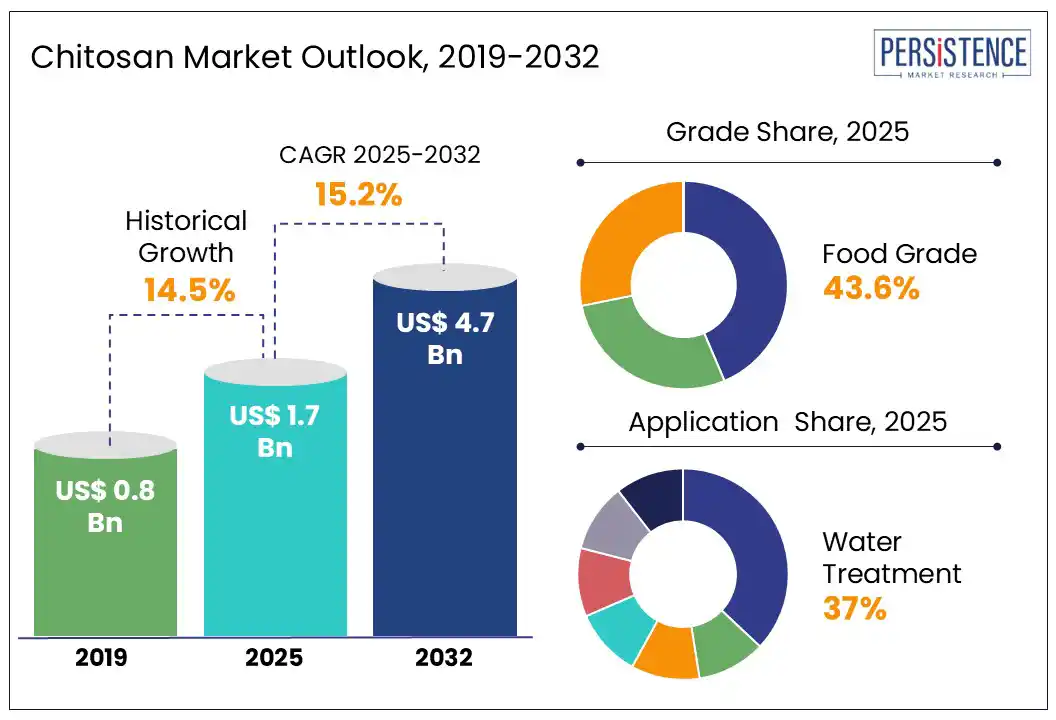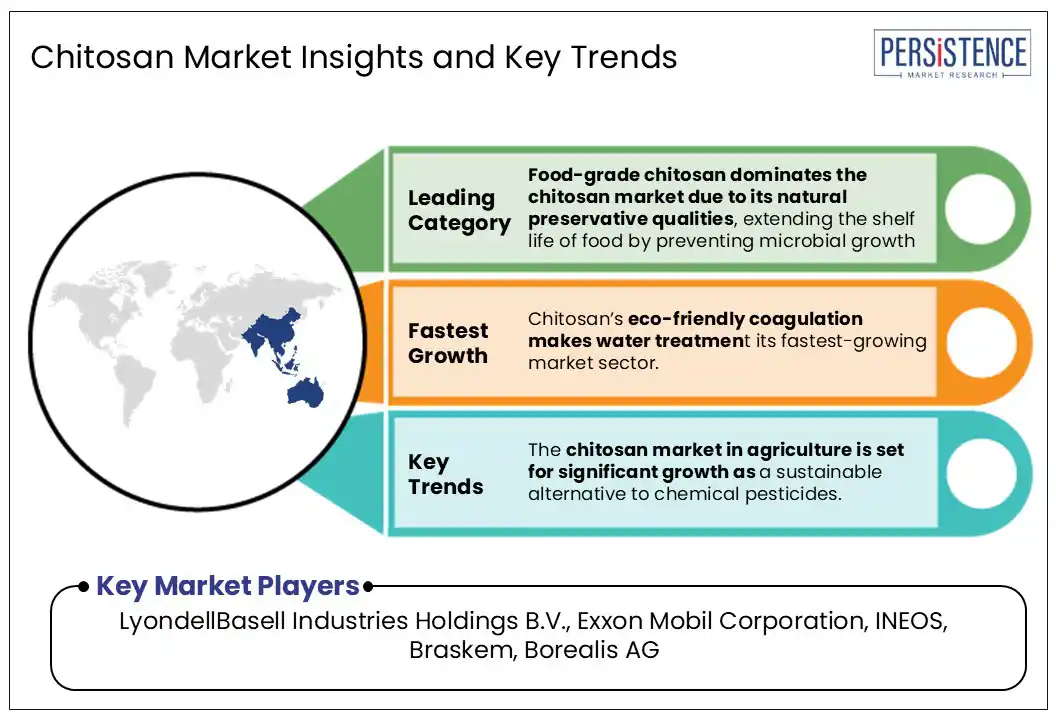ID: PMRREP35471| 200 Pages | 8 Jul 2025 | Format: PDF, Excel, PPT* | Chemicals and Materials

The global chitosan market size is valued at US$ 1.7 billion in 2025 and is expected to reach US$ 4.7 billion in 2032, growing at a CAGR of 15.2% during the forecast period from 2025 to 2032.
According to the Persistence Market Research report the chitosan market is growing due to its biodegradability, antimicrobial properties, and sustainable applications in various industries. Derived from crustacean shells, it faces high costs and supply limitations.
Asia Pacific leads due to seafood processing, while North America and Europe expand in biomedical and cosmetics. Increasing research in nanotechnology and medicine is unlocking new opportunities, driving market demand for sustainable and high-performance biomaterials.

Key Industry Highlights:
|
Global Market Attribute |
Key Insights |
|
Chitosan Market Size (2025E) |
US$ 1.7 Bn |
|
Market Value Forecast (2032F) |
US$ 4.7 Bn |
|
Projected Growth (CAGR 2025 to 2032) |
15.2% |
|
Historical Market Growth (CAGR 2019 to 2024) |
14.5% |
Advancements in chitosan-based drug delivery systems are significantly boosting the chitosan market. Its mucoadhesive properties, biocompatibility, and ability to enhance drug solubility make chitosan a vital excipient in pharmaceuticals. It's widely used in oral drug delivery and transdermal patches for improved absorption and controlled release. Chitosan nanoparticles are gaining traction in targeted delivery, minimizing dosage frequency and side effects. With increased R&D in nanomedicine and biopharmaceuticals, the demand for chitosan drug carriers is rising.
According to the Journal of Pharmacy & Pharmaceutical Sciences, Chitosan is widely used in drug delivery, particularly in particulate carriers for therapeutics and vaccines. Its adjuvant properties have led to its application in various hydrogels and as a coating material. This review focuses on chitosan as a vaccine adjuvant, its use in non-particulate delivery systems such as thermosensitive hydrogels and microneedles, and the benefits of its role as a coating material for vaccine carriers.
Chitosan's limited solubility and stability present significant challenges for its commercial applications, hindering market growth. As a natural polysaccharide, chitosan is insoluble in water and only dissolves under acidic conditions (pH < 6), which complicates its incorporation into pharmaceutical, cosmetic, and food formulations.
Furthermore, it displays poor stability when exposed to extreme pH levels, high temperatures, and enzymatic conditions, leading to degradation and a loss of functionality over time. These limitations restrict its large-scale adoption in industries that require consistent solubility, bioavailability, and extended shelf life. As a result, manufacturers are increasingly looking for chemical modifications or alternative biopolymers to achieve better performance and processing efficiency.
The chitosan market in agriculture is set for significant growth as a sustainable alternative to chemical pesticides. With stricter regulations on synthetic agrochemicals and rising consumer demand for organic solutions, chitosan's biodegradability and antimicrobial properties make it an effective plant growth enhancer and biopesticide. Its ability to adsorb heavy metals also improves soil and water quality. As farmers seek eco-friendly crop protection, the adoption of chitosan-based formulations is expected to increase.
In 2024, Eden Biotech, a Brazilian company, launched chitosan-based bio fertilizers aimed at enhancing crop resilience and productivity. These products utilize chitosan’s biostimulant and antimicrobial properties to boost plant immunity and nutrient uptake while protecting against pathogens without synthetic chemicals.
Food-grade chitosan dominates the chitosan market due to its natural preservative qualities, extending the shelf life of food by preventing microbial growth. It is favored over synthetic preservatives and is commonly used as a thickener, stabilizer, and emulsifier in functional foods and dietary supplements, promoting gut health and weight management. Its eco-friendly nature and role in water purification aligns with clean-label trends, bolstered by regulatory approvals from the FDA and EFSA. The demand for biodegradable, plant-based, and vegan-friendly ingredients drives its global market growth.
In 2024, Primex highlighted the importance of food-grade chitosan with their product, ChitoClear, used in the food and beverage industry for its natural preservative properties that extend shelf life by inhibiting microbial growth. ChitoClear also functions as a thickener and stabilizer in various applications. Primex sources chitosan from shrimp shells, demonstrating their commitment to sustainability and meeting consumer demand for eco-friendly food additives.
The water treatment industry is the fastest growing sector in the chitosan market due to the eco-friendly coagulation properties of chitosan, which effectively removes heavy metals, organic pollutants, and suspended solids. Increasing regulatory pressures regarding water quality, alongside the demand for biodegradable alternatives to traditional coagulants, are driving this demand. Chitosan is widely used in municipal wastewater treatment, industrial effluent management, and desalination. Its ability to enhance sludge dewatering and prevent membrane biofouling makes it essential for water purification.

Asia Pacific dominates the chitosan market due to the abundant availability of shrimp and crab shells, key raw materials for production. Countries such as China, India, Thailand, Vietnam, and Indonesia have thriving seafood industries that generate significant crustacean waste, enabling cost-effective chitosan extraction and reducing reliance on synthetic alternatives. The strong aquaculture sector and government initiatives promoting waste valorization further support market growth.
The chitosan market is thriving in Europe, driven by strict EU regulations on synthetic preservatives in the food, pharmaceutical, and cosmetic sectors. Regulatory bodies such as the European Food Safety Authority (EFSA) and REACH encourage the use of natural, biodegradable alternatives, boosting demand for chitosan as a non-toxic, antimicrobial compound used in food preservation, drug delivery, wound care, and personal care products.
The significant R&D investments by European companies to meet safety and sustainability standards. The European Medicines Agency (EMA) and REACH advocate for biodegradable alternatives, prompting the development of chitosan-based pharmaceuticals, medical devices, and bioplastics. Furthermore, government initiatives and collaborations between biotech Companies and universities foster innovation, positioning Europe as a leader in natural polymers and green biotechnology.
The North American chitosan market is growing due to its increasing use in biomedical and pharmaceutical applications, particularly in drug delivery, wound healing, and tissue engineering. This growth is largely attributed to chitosan's biocompatibility and biodegradability. The United States is at the forefront of research and development investments and has a robust regulatory framework, including FDA approvals for chitosan-based medical products.
Innovations in nanotechnology, such as chitosan nanoparticles for targeted cancer drug delivery and nano gels for overcoming the blood-brain barrier in the treatment of neurodegenerative diseases, demonstrate North America's leadership in this sector. With rising healthcare investments and advancements in biotechnology, the demand for chitosan in advanced medical applications continues to increase. Notably, the U.S. Food and Drug Administration (FDA) granted 510(k) clearance to Axiostat Chitosan Hemostatic Dressing, a chitosan-based product designed to quickly stop external bleeding.
The global chitosan market is extremely competitive, with leading companies concentrating on product development, strategic collaborations, and expansion to enhance their market presence. The companies prioritize research and development to create high-quality chitosan for use in pharmaceuticals, water treatment, cosmetics, and agriculture. Mergers and acquisitions frequently occur, as businesses seek to broaden their production capabilities and geographic reach. For example, manufacturers are partnering with biotech companies to improve product purity and functionality.
Moreover, the growing interest in non-animal-derived chitosan is intensifying competition, with companies investing in fungal chitosan as a vegan option. Asia Pacific, especially China, Japan, and India, is at the forefront of the market, thanks to the availability of abundant raw materials and increasing demand from the healthcare and food sectors. In summary, ongoing innovation and sustainability initiatives are pivotal in shaping the competitive environment of the market.
The chitosan market is estimated to be valued at US$ 1.7 Bn in 2025.
Chitosan’s rising role in advanced drug delivery systems enhances bioavailability & targeted release is the key demand driver for the chitosan market.
In 2025, Asia Pacific dominates the market with ~32.1% share in the global chitosan market.
Among Grades, preference for the Food grade segment is expected to grow rapidly at 16.2% CAGR from 2025-2032.
ChitoLytic, Heppe Medical Chitosan GmbH, and COMGRAF SAS are the leading players in the Chitosan market.
|
Report Attribute |
Details |
|
Historical Data/Actuals |
2019 - 2024 |
|
Forecast Period |
2025 - 2032 |
|
Units |
Value: US$ Bn, Volume: Tonnes |
|
Geographical Coverage |
|
|
Segmental Coverage |
|
|
Competitive Analysis |
|
|
Report Highlights |
|
|
Customization and Pricing |
Available upon request |
By Grade
By Application
By Region
Delivery Timelines
For more information on this report and its delivery timelines please get in touch with our sales team.
About Author